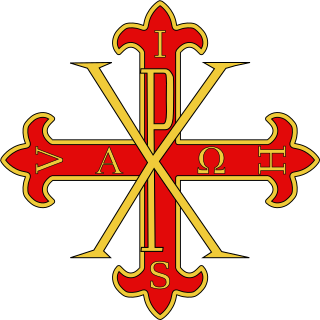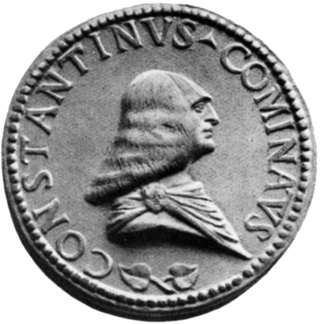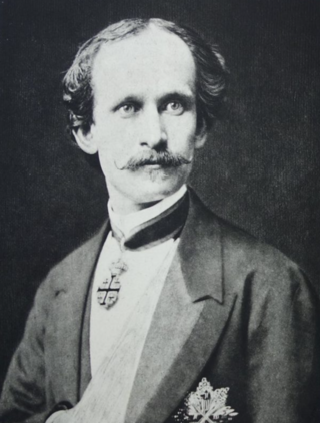
The Sacred Military Constantinian Order of Saint George, also historically referred to as the Imperial Constantinian Order of Saint George and the Order of the Constantinian Angelic Knights of Saint George, is a dynastic order of knighthood of the House of Bourbon-Two Sicilies. Currently, the grand magistry of the order is disputed among the two claimants to the headship of the formerly reigning House of Bourbon-Two Sicilies as heirs of the House of Farnese, namely Prince Pedro and Prince Carlo. The order was one of the rare orders confirmed as a religious-military order in the papal bull Militantis Ecclesiae in 1718, owing to a notable success in liberating Christians in the Peloponnese. Together with the Sovereign Military Order of Malta, it is one of a small number of Catholic orders that still have this status today. It is not an order of chivalry under the patronage of the Holy See, but its membership is restricted to practising Catholics.
Andrea Thopia was a 15th century Albanian nobleman whose domains included the territory of Scuria. He was a member of the Thopia family and one of the founders of the League of Lezhë.

Constantine Cominato Arianiti also known as Constantine Komnenos Arianites, was a 15th and 16th-century Albanian nobleman, military leader, diplomat and pretender who lived most of his life in exile in Italy due to the conquest of his homeland by the Ottoman Empire. Constantine sought to establish himself as a leader among the Christian Balkan refugees in Italy and claimed lordship over various former Christian lands in Greece, using the titles Prince of Macedonia, Duke of Achaea and Despot of the Morea.
Since its fall, the issue of succession to the Byzantine Empire has been a major point of contention both geopolitically, with different states laying claim to its legacy and inheritance, and among the surviving members of the Byzantine nobility and their descendants. Historically, the most prominent claims have been those of the Ottoman Empire, which conquered Byzantium in 1453 and ruled from its former capital, Constantinople; the Russian Empire, as the most powerful state practising Eastern Orthodox Christianity; and various nobles and figures in Western Europe of increasingly spurious and questionable imperial descent.
Arianitto Cominato Arianiti was a 16th-century Italian nobleman of Albanian descent, the only son of the diplomat and pretender Constantine Arianiti. After his father's death in 1530, Arianitto continued Constantine's pretensions, styling himself as the 'Prince of Macedonia', but dropping the other titles used by his father. He served as a captain in the papal army in Rome until his death in battle in 1551, which ended the male line of the Arianiti family in Italy.

Gian Antonio Lazier, also known under his claimed official name Ioannes IX Antonius I Angelus Flavius Comnenus Lascaris Palaeologus, and various variations thereof, was an 18th-century Italian impostor and pretender. Born of lowly origins in the Aosta Valley in Italy, Lazier claimed his last name to be a corruption of the surname Laskaris, an imperial dynasty of the Byzantine Empire. Also claiming connections to the Angelos, Komnenos and Palaiologos dynasties as their supposed last legitimate descendant, Lazier claimed the style 'prince of the line of the empire of the east'. Through various noble titles, Lazier claimed to be the rightful ruler of a vast number of former territories of the Byzantine Empire as well as of a selection of other eastern lands. He also claimed to represent the legitimate Grand Master of the Sacred Military Constantinian Order of Saint George, a chivalric order with invented Byzantine connections.

Demetrius Rhodocanakis was a London-based 19th-century Greek merchant, forger and pretender. Demetrius was the last great Byzantine pretender, claiming to be a prince directly descended from the Palaiologos dynasty of the Byzantine Empire from the 1860s onwards, and then the rightful Emperor of Constantinople, as Demetrios II Dukas Angelos Komnenos Palaiologos Rhodokanakis, from 1895 to his death. Though he lost support after 1895 due to his claims of Byzantine descent having been exposed as forgeries, Demetrius was at one point widely recognized as a Byzantine prince, achieving the recognition of not only the British Foreign Office, but also Pope Pius IX.
Andrea Angeli was the Grand Master of the Constantinian Order of Saint George from c. 1545 to 1580. Andrea and his brother Paolo were the founders of the Sacred Military Constantinian Order of Saint George and were papally recognized claimants to descent from the Angelos dynasty of Byzantine emperors. Andrea claimed the title "Duke and Count of Drivasto and Durazzo", and from the death of Arianitto Arianiti in 1551, also claimed the title "Prince of Macedonia".
Giovanni Demetrio Angeli was an early member of the Albanian-Italian Angelo Flavio Comneno family, which claimed descent from the Angelos dynasty of Byzantine emperors. His later relatives attributed him various titles, such as "Prince of Achaea and Macedonia" and "Prince of Cilicia".
Girolamo I Angeli was a joint, or rival, Grand Master of the Constantinian Order of Saint George from 1570 to 1591, together with, or against, his brother Andrea and then his nephew Pietro. Girolamo's family, the Angelo Flavio Comneno, claimed descent from the Angelos dynasty of Byzantine emperors, and Girolamo also claimed the title "Prince of Thessaly".
Pietro Angelo Flavio was the Grand Master of the Constantinian Order of Saint George from 1580 to 1592. Pietro's family, the Angelo Flavio Comneno, claimed descent from the Angelos dynasty of Byzantine emperors, and Pietro also claimed the titles "Prince of Cilicia and Macedonia" and "Duke and Count of Drivasto and Durazzo".

Giovanni Andrea I Angelo Flavio Comneno was the Grand Master of the Constantinian Order of Saint George from 1592 to 1623 and from 1627 to 1634. In addition to the position of grand master, Giovanni Andrea also claimed the titles "Prince of Macedonia" and "Duke and Count of Drivasto and Durazzo". Giovanni Andrea oversaw a period of internationalization of the Constantinian Order, and despite repeated challenges to his position managed to maintain the widespread recognition of his order and family.

Angelo Maria Angelo Flavio Comneno was the Grand Master of the Constantinian Order of Saint George from 1634 to 1678. Angelo Maria's family, the Angelo Flavio Comneno, claimed descent from the Angelos dynasty of Byzantine emperors, and Angelo Maria also claimed the titles "Prince of Macedonia and Thessaly" and "Duke and Count of Drivasto and Durazzo".
Marco Angelo Flavio Comneno was according to the official reconstruction of the Sacred Military Constantinian Order of Saint George the grand master of the order from 1678 to 1679, though the historicity of his tenure as grand master has been questioned on the basis that he might in actuality have predeceased his supposed predecessor, his older brother Angelo Maria Angeli. Marco's family, the Angelo Flavio Comneno, claimed descent from the Angelos dynasty of Byzantine emperors. The modern Constantinian Order attributes Marco the titular titles previously used by his older brother; "Prince of Macedonia and Thessaly" and "Duke and Count of Drivasto and Durazzo".
Girolamo II Angelo Flavio Comneno was the Grand Master of the Constantinian Order of Saint George from 1679 to 1687. Girolamo's family, the Angelo Flavio Comneno, claimed descent from the Angelos dynasty of Byzantine emperors, and Girolamo also claimed the titles "Prince of Macedonia" and "Duke and Count of Drivasto and Durazzo".

Giovanni Andrea II Angelo Flavio Comneno was the Grand Master of the Constantinian Order of Saint George from 1687 to 1698. Giovanni Andrea's family, the Angelo Flavio Comneno, claimed descent from the Angelos dynasty of Byzantine emperors, and Giovanni Andrea also claimed the titles "Prince of Macedonia" and "Duke and Count of Drivasto and Durazzo". The last male member of his family, Giovanni Andrea was the last grand master descended from the order's founder, Andrea Angeli. In 1687, Giovanni Andrea sold the position of grand master to Francesco Farnese, the Duke of Parma, and thereafter lived as a castellan in Piacenza.
John George Heracleus Basilicos was a mercenary and pretender, mainly active in Italy in the late 16th century and early 17th century. Heracleus claimed to be a descendant of the Roman emperor Heraclius and through a varying assortment of titles claimed to be the legitimate ruler of the Peloponnese, Macedonia, Moldavia, Wallachia and Albania. Until 1593, he also claimed to be the Grand Master of the Constantinian Order of Saint George, in opposition to the legitimate grand masters Andrea, Pietro and Giovanni Andrea I Angeli.

Domenico (Moncino) Musachi or Muzaka is the father of Vojsava Kastrioti, according to the genealogy provided in Gjon Muzaka's "Breve memoria de li discendenti de nostra casa Musachi". Nothing more is known about him, except he was the brother of Gjin Maria Musachi. Domenico had another daughter, Agnese, the mother of Andrea Angeli. Judging by the name Domenico, he must have been baptized into Catholicism. That the Angeli family were relatives of Kastrioti-Skanderbeg, is attested in historical records:
The Regalia of Albania is a royal regalia that existed during the Albanian monarchy. The regalia worn by Albanian nobles, spanning various aristocratic families, included royal symbols, artifacts, and ceremonial aspects. These regal emblems were emblematic of the monarchy's power and heritage, representing a broader spectrum of Albanian noble history. The historical and cultural value attached to these symbols transcends individual families, signifying the collective richness of Albania's noble traditions throughout different periods.












